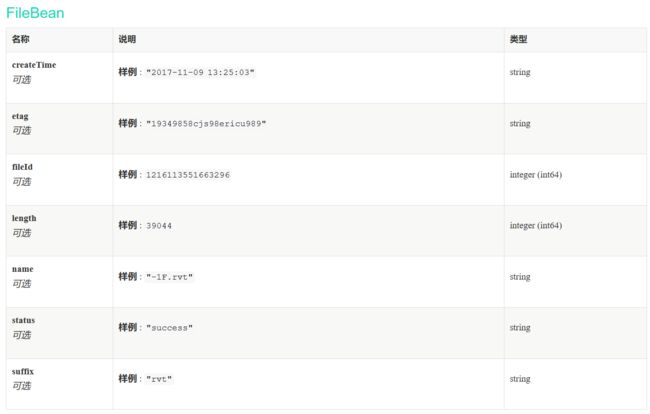在《C#开发BIMFACE系列4 服务端API之源上传文件》、《C#开发BIMFACE系列5 服务端API之文件直传》两篇文章中详细介绍了如何将本地文件上传到BIMFACE服务器及BIMFACE后台的分布式存储系统中。文件上传成功后,BIMFACE的服务会返回与该文件相关的信息,如下图:
开发者在成功上传了文件并获得相关文件信息后,可以将信息保存到数据库中供后续的业务开发使用。
除此之外,BIMFACE平台还提供了单独的服务用于获取文件信息、获取文件信息列表、获取文件上传的状态信息、获取应用支持的文件类型。
下面分别介绍各种服务的使用方法。
请求地址: GET https://file.bimface.com/files/{fileId}
说明:根据文件ID获取文件详细信息
参数:
请求 path(示例):https://file.bimface.com/files/1419273043501216
请求 header(示例):"Authorization: Bearer dc671840-bacc-4dc5-a134-97c1918d664b"
HTTP响应示例(200):
{ "code" : "success", "data" : { "createTime" : "2017-11-09 13:25:03", // 文件的上传时间 "etag" : "19349858cjs98ericu989", // 存储文件的额外属性 "fileId" : 1216113551663296, // 文件编号 "length" : 39044, // 文件的大小 "name" : "-1F.rvt", // 文件的名称 "status" : "success", // 文件的上传状态 "suffix" : "rvt" // 文件的后缀名 }, "message" : "" }
C#实现方法:
1 ///2 /// 根据文件ID获取文件详细信息 3 /// 4 /// 令牌 5 /// 文件ID 6 /// 7 public virtual FileInfoGetResponse GetFileInfo(string accessToken, string fileId) 8 { 9 //GET https://file.bimface.com/files/{fileId} 10 string url = string.Format(BimfaceConstants.FILE_HOST + "/files/{0}", fileId); 11 12 BimFaceHttpHeaders headers = new BimFaceHttpHeaders(); 13 headers.AddOAuth2Header(accessToken); 14 15 try 16 { 17 FileInfoGetResponse response; 18 19 HttpManager httpManager = new HttpManager(headers); 20 HttpResult httpResult = httpManager.Get(url); 21 if (httpResult.Status == HttpResult.STATUS_SUCCESS) 22 { 23 response = httpResult.Text.DeserializeJsonToObject (); 24 } 25 else 26 { 27 response = new FileInfoGetResponse 28 { 29 Message = httpResult.RefText 30 }; 31 } 32 33 return response; 34 } 35 catch (Exception ex) 36 { 37 throw new Exception("[根据文件ID获取文件详细信息]发生异常!", ex); 38 } 39 }
其中引用的 httpManager.Get() 方法如下:
////// HTTP-GET方法,(不包含body数据)。 /// 发送 HTTP 请求并返回来自 Internet 资源的响应(HTML代码) /// /// 请求目标URL /// HTTP-GET的响应结果 public HttpResult Get(string url) { return RequestString(url, null, HttpMethod.GET, null); }
1 ///2 /// HTTP请求(包含文本的body数据) 3 /// 4 /// 请求目标URL 5 /// 主体数据(普通文本或者JSON文本)。如果参数中有中文,请使用合适的编码方式进行编码,例如:gb2312或者utf-8 6 /// 请求的方法。请使用 HttpMethod 的枚举值 7 /// HTTP 标头的值。请使用 ContentType 类的常量来获取 8 /// 9 private HttpResult RequestString(string url, string data, string method, string contentType) 10 { 11 HttpResult httpResult = new HttpResult(); 12 HttpWebRequest httpWebRequest = null; 13 14 try 15 { 16 httpWebRequest = WebRequest.Create(url) as HttpWebRequest; 17 httpWebRequest.Method = method; 18 httpWebRequest.Headers = HeaderCollection; 19 httpWebRequest.CookieContainer = CookieContainer; 20 if (!string.IsNullOrWhiteSpace(contentType)) 21 { 22 httpWebRequest.ContentType = contentType;// 此属性的值存储在WebHeaderCollection中。如果设置了WebHeaderCollection,则属性值将丢失。所以放置在Headers 属性之后设置 23 } 24 httpWebRequest.UserAgent = _userAgent; 25 httpWebRequest.AllowAutoRedirect = _allowAutoRedirect; 26 httpWebRequest.ServicePoint.Expect100Continue = false; 27 28 if (data != null) 29 { 30 httpWebRequest.AllowWriteStreamBuffering = true; 31 using (Stream requestStream = httpWebRequest.GetRequestStream()) 32 { 33 requestStream.Write(EncodingType.GetBytes(data), 0, data.Length);//将请求参数写入请求流中 34 requestStream.Flush(); 35 } 36 } 37 38 HttpWebResponse httpWebResponse = httpWebRequest.GetResponse() as HttpWebResponse; 39 if (httpWebResponse != null) 40 { 41 GetResponse(ref httpResult, httpWebResponse); 42 httpWebResponse.Close(); 43 } 44 } 45 catch (WebException webException) 46 { 47 GetWebExceptionResponse(ref httpResult, webException); 48 } 49 catch (Exception ex) 50 { 51 GetExceptionResponse(ref httpResult, ex, method, contentType); 52 } 53 finally 54 { 55 if (httpWebRequest != null) 56 { 57 httpWebRequest.Abort(); 58 } 59 } 60 61 return httpResult; 62 }
在BIMFACE的控制台中可以看到我们上传的文件列表

选择任意一个文件的ID来做测试

可以看到获取文件信息成功,返回了以下信息:文件的上传时间、存储文件的额外属性、文件编号、文件的大小、文件的名称、文件的上传状态、文件的后缀名。
测试程序如下:1 // 获取文件信息 2 protected void btnGetFileInfo_Click(object sender, EventArgs e) 3 { 4 txtFileInfo.Text = string.Empty; 5 6 string token = txtAccessToken.Text; 7 string fileId = txtFileId.Text; 8 9 FileApi api = new FileApi(); 10 FileInfoGetResponse response = api.GetFileInfo(token, fileId); 11 12 txtFileInfo.Text = response.Code 13 + Environment.NewLine 14 + response.Message 15 + Environment.NewLine 16 + response.Data.ToString(); 17 }

